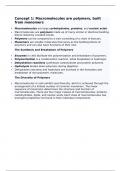Concept 1: Macromolecules are polymers, built
from monomers
Macromolecules are large carbohydrates, proteins, and nucleic acids.
Macromolecules are polymers made up of many similar or identical building
blocks linked by covalent bonds.
Polymers can be compared to a train consisting of a chain of boxcars.
Monomers are smaller molecules that serve as the building blocks of
polymers and can also have functions of their own.
The Synthesis and Breakdown of Polymers
Enzymes in cells facilitate the polymerization and breakdown of polymers.
Polymerization is a condensation reaction, while breakdown is hydrolysis.
Dehydration reactions synthesize carbohydrate and protein polymers.
Hydrolysis breaks down polymers during digestion.
Dehydration reactions and hydrolysis are involved in the formation and
breakdown of non-polymeric molecules.
The Diversity of Polymers
Macromolecules in cells exhibit vast diversity, which is achieved through the
arrangement of a limited number of common monomers. The linear
sequence of monomers determines the structure and function of
macromolecules. There are four major classes of macromolecules: proteins,
carbohydrates, lipids, and nucleic acids. Each class of macromolecules has
emergent properties not found in their individual components.
, Concept 2: Carbohydrates serve as fuel and
building material
Carbohydrates are composed of sugars and polymers of sugars, playing
essential roles in energy storage, structural support, and cell signaling.
Monosaccharides are single sugar molecules that serve as building blocks
for more complex carbohydrates, such as glucose, fructose, and galactose.
Disaccharides, like sucrose and lactose, are formed by the covalent
bonding of two monosaccharides through a condensation reaction.
Polysaccharides, including starch, glycogen, and cellulose, are complex
carbohydrate macromolecules that function in energy storage and structural
support.
Sugars
Monosaccharides are single sugar molecules with molecular formulas that
are multiples of the unit CH2O.
Glucose is the most common monosaccharide and is of central importance in
the chemistry of life.
Monosaccharides can be classified as aldoses (carbonyl group at the end) or
ketoses (carbonyl group in the middle).
Monosaccharides can also be classified based on the size of their carbon
skeleton, ranging from three to seven carbons long.
Glucose and fructose are isomers, with fructose being a sweeter-tasting
isomer of glucose.
, Monosaccharides can have different spatial arrangements around
asymmetric carbons, leading to distinctive shapes and binding activities.
In aqueous solutions, monosaccharides, including glucose, form rings, which
are the most stable form under physiological conditions.
Monosaccharides, particularly glucose, are major nutrients for cells and serve
as a fuel source for cellular respiration.
Monosaccharides also serve as raw material for the synthesis of other
organic molecules, such as amino acids and fatty acids.
Disaccharides are formed by the joining of two monosaccharides through a
glycosidic linkage.
Examples of disaccharides include maltose (two glucose molecules), sucrose
(glucose and fructose), and lactose (glucose and galactose).
Disaccharides need to be broken down into monosaccharides to be used for
energy by organisms.
Lactose intolerance occurs when individuals lack the enzyme lactase, leading
to digestive issues.
Sucrose is the most prevalent disaccharide and is commonly found in table
sugar.
Polysaccharides
Polysaccharides are macromolecules made up of monosaccharides joined by
glycosidic linkages.
They can serve as storage material or building material for structures.
Plants store starch as granules within plastids, while animals store glycogen
mainly in liver and muscle cells.
Starch can be hydrolyzed to release glucose, a cellular fuel.
Cellulose is a major component of plant cell walls and the most abundant
organic compound on Earth.
Humans and most animals cannot digest cellulose, so it passes through the
digestive tract.
Chitin is a structural polysaccharide found in arthropods and fungi, used to
build exoskeletons and cell walls.
Concept 3: Lipids are a diverse group of
hydrophobic molecules
Lipids are large biological molecules that are not polymers and are not
considered macromolecules.




